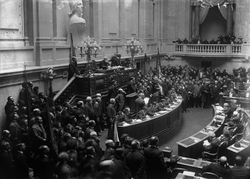Constitution of Portugal
The current Constitution of Portugal was adopted in 1976 after the Carnation Revolution.[1]
| Constitution of the Portuguese Republic | |
|---|---|
 | |
| Overview | |
| Jurisdiction | Portugal |
| Ratified | 2 April 1976 |
| Date effective | 25 April 1976 |
| System | Semi-presidential |
| Government structure | |
| Branches | 4 |
| Head of state | President with significant reserve powers |
| Chambers | Unicameral (Assembly of the Republic) |
| Executive | Government, headed by a Prime Minister |
| Judiciary | Constitutional Court, Supreme Court of Justice and lower general courts, Supreme Administrative Court and lower administrative courts and Court of Auditors |
| Federalism | Unitary state, but the outermost archipelagoes enjoy self-government |
| Electoral college | No |
| Entrenchments | 15 (14 material ones and a circumstantial one) |
| History | |
| First legislature | 3 June 1976 |
| First executive | 23 July 1976 |
| Amendments | 7 |
| Last amended | 2005 |
| Author(s) | Constituent Assembly of Portugal |
| Signatories | Henrique de Barros and Francisco da Costa Gomes |
| Supersedes | Portuguese Constitution of 1933 |
| Full text | |
Constitution Of Portugal Media
References
- ↑ "The Constitution of 1976 and subsequent revisions". The Constitutional Monarchy. Assembly of the Republic of Portugal. Archived from the original on 22 October 2013. Retrieved 12 December 2013.
